From the Director General
It has been another busy period for the Department of Mines and Petroleum as we progress into the new financial year, and in the latest edition of the DG’s eNews we take a look at the number of achievements made by the agency since the start of the year.
Of significance is the continuation of environmental reform under the Reforming Environmental Regulation (RER) program.
The first compulsory year of the Mining Rehabilitation Fund saw disturbance data collected from all but 34 of the State’s more than 22,000 mining tenements. More than $33 million has been paid into the fund to date and more than $777,000 in interest has been earned on the fund.
The Petroleum Division has also been busy developing new regulations for the petroleum and geothermal industries which came into effect on 1 July 2015.
These new regulations give Western Australia the most stringent environmental conditions in the country regarding the emerging shale and tight gas industry.
Recent economic impact study shows that every $1 million invested in the State Government’s Exploration Incentive Scheme (EIS) stimulates exploration activity generating $10.3 million in direct benefits for Western Australia.
The second stage of the modelling resulted in a further $13.4 million of benefits for every $1 million invested bringing the total impact figure to $23.7 million.
The review by ACIL Allen Consulting highlights new pre-competitive geoscience as the main driver of private sector exploration investment.
In other developments, the Mineral Titles Division has updated its online tenement system to address concerns about access to surrendered tenements, and now details are freely available online, while the Geological Survey has been developing a number of tablet and smartphone apps.
This edition of the DG’s eNews also features the latest news from DMP’s successful Aboriginal Employment Strategy and recent NAIDOC Week celebrations, and the details of the WorkSafe Gold Certificate of Achievement officially presented to DMP in June.
The DG’s eNews is a valuable tool for anyone interested in the future of the Western Australian mining and petroleum industry and provides updates on the latest activities of the department, so please recommend it to your industry colleagues.
Richard Sellers
Director General
Department of Mines and Petroleum
Major achievements at DMP for 2015
In a recent address to 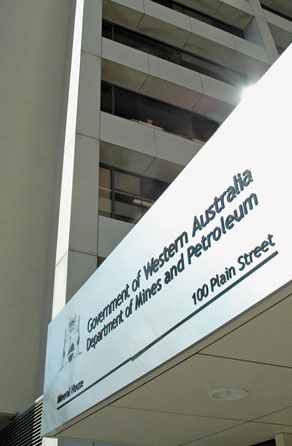 Department of Mines and Petroleum (DMP) staff, Director General Richard Sellers outlined a number of achievements made at the agency since the start of the year.
Department of Mines and Petroleum (DMP) staff, Director General Richard Sellers outlined a number of achievements made at the agency since the start of the year.
“Of significance is the continuation of environmental reform under the Reforming Environmental Regulation (RER) program. The Mining Legislation Amendment Bill 2015 was introduced to the Western Australian parliament on 22 April 2015. The bill will amend the Mining Act 1978 to allow for the final stage of RER program reform," Mr Sellers said.
“The area of mining and exploration land under rehabilitation in Western Australia has increased seven per cent in 2014-15, compared with 2013-14. Ground disturbance data must now be reported annually and the second compulsory reporting period for the fund closed on 30 June 2015 and at that time 98 per cent of reports had been submitted online – a great result,” he said.
The first compulsory year of the Mining Rehabilitation Fund saw disturbance data collected from all but 34 of more than 22,000 mining tenements in the state. More than $33 million has been paid into the fund to date and more than $777,000 in interest has been earned on the fund.
Mr Sellers said the Petroleum Division had been busy developing new regulation for the petroleum and geothermal industries which came into effect on 1 July 2015. These new regulations will give Western Australia the most stringent environmental conditions in the country relating to the emerging shale and tight gas industry.
Representatives from the Petroleum and Environment Divisions travelled to Broome in February to proactively engage with stakeholders about the emerging onshore gas industry. Community Open Days in Broome and Derby in March also saw DMP and Department of Water subject matter experts answer questions on design and long-term well integrity, land access, use of chemicals and the protection of aquifers.
“Additionally, Royalties and Mineral Titles have completed the integration of their respective business systems, Royalty Management System (RMS) and eMITs, to share information. The integration was timely resulting in the immediate reaction to Atlas shares being suspended to protect outstanding royalty revenue,” he said
The final report of the comprehensive review of the State’s royalty system, the Mineral Royalty Rate Analysis, was tabled in Parliament on 25 March.
Another positive achievement was made by Mineral Titles which had reduced the backlog of all pending applications in Area 2, for the financial year 2014/15, by more than 30 per cent.
Mr Sellers said the department’s Digital DMP initiative made significant progress towards all customer transactions being conducted digitally by July 2016.
“Internal launches of Digital DMP were held at our headquarters at Mineral House in Perth, along with regional offices in Karratha, Collie and in Kalgoorlie during April and May,” Mr Sellers said.
In February DMP hosted the inaugural Uranium Regulators Workshop which included representatives from DMP, DER, OEPA, DoW, Radiological Council and DSD.
“The purpose of the workshop was to better understand the roles and obligations of agencies with statutory responsibilities associated with the regulation of uranium mining,” Mr Sellers said.
For the second year in a row, DMP was named the top ranking graduate employer of State Government departments in Western Australia. The department was also ranked 15th overall in Australia in the nation-wide survey of graduates.
Mr Sellers also told staff that Western Australia’s resources sector is currently transitioning from high rates of capital investment in new projects, and expansion of existing projects, to a period of higher levels of production and export.
He said the longer term outlook for the resources sector remained positive and the State was in a good position for future upswings in commodity prices.
New petroleum and geothermal resource management regulations
Western Australia 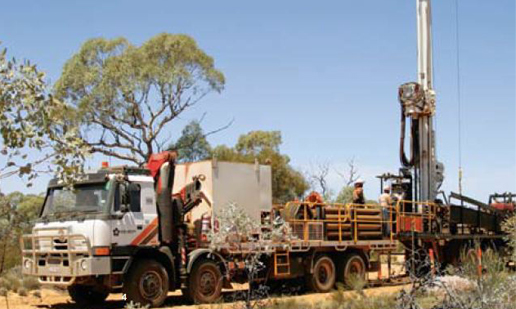 now has some of the strongest well integrity and resource management conditions in the country for its emerging shale and tight gas industry following the introduction of new regulations for the petroleum and geothermal industries on July 1.
now has some of the strongest well integrity and resource management conditions in the country for its emerging shale and tight gas industry following the introduction of new regulations for the petroleum and geothermal industries on July 1.
Department of Mines and Petroleum executive Director of Petroleum Division Jeff Haworth said these regulations complement the existing safety and environmental regulations.
“While WA’s natural gas from shale and tight rocks industry is in the early stages of exploration, with any significant commercial production predicted to be about five to ten years away, it is important that a robust regulatory framework is in place,” Mr Haworth said.
“The State Government understands community concerns associated with hydraulic fracturing and strengthening regulations and ensuring best practices are implemented is critical to addressing these concerns.”
Before drilling operations are approved DMP assesses applications to ensure work is conducted in accordance with good oil field practices and in a way that reduces the risk to the environment.
“The department will ensure any future projects are assessed on a site-by-site, project-by- project basis with safety and environment auditors conducting inspections to check compliance with safety and environmental standards,” Mr Haworth said.
“As part of the approvals process, companies are legally required to provide an environment plan that assesses the potential impacts on groundwater, as well as flora and fauna.
“All companies are required to submit a list of all chemicals to be used in all well operations. This information is available on the DMP website. WA is the only jurisdiction in Australia requiring full public disclosure of chemicals..”
Mr Haworth said the State is well positioned to learn from experiences in other jurisdictions and to adopt international best practice standards to further strengthen its robust regulatory system ensuring the environment and communities are protected as this new industry is developed.
“With the new regulations now in place DMP is confident it can strictly regulate a shale and tight gas industry without compromising the environment or safety to successfully maximise possible future economic opportunities for all Western Australians,” he said.
DMP received significant input on the consultation draft of the regulations and supporting guideline documents, and many of these have been incorporated into the regulations.
“Further to this, earlier this year a meeting was held by DMP with the Shale and Tight Gas Inter-Agency Working Group, comprising representatives from the Departments of Water, Health, Environment Regulation, Agriculture and Food, Parks and Wildlife and State Development to discuss the changes.”
A multi-agency regulatory framework for shale and tight gas is also being developed to assist industry with the changes to the legislation.
Community consultation
In response to community requests for information on hydraulic fracture stimulation DMP’s Petroleum Division has held a number of community information sessions throughout the State during the year.
DMP officers met with various local government, business and community groups in the Kimberley, Pilbara, Mid-West and Gascoyne regions which has facilitated better planned and more informed policies, programs, projects and services.
As well as public meetings, consultation occurred with shire representatives, non-government organisations, regional development authorities, Aboriginal groups, and agricultural representatives, with additional attendance at booths at regional expos and agricultural shows.
Further public and stakeholder consultation sessions will be held throughout the State throughout the year.
As part of the approvals process companies will be required to consult early with communities where exploration licences have been granted.
Petroleum and Geothermal Energy regulations
- The changes to the Petroleum and Geothermal Energy Resources (Resource Management and Administration) Regulations 2014 follow extensive consultation by DMP with industry stakeholders and the public.
- The draft Petroleum and Geothermal Energy Resources (Resource Management and Administration) Regulations 2014 cover the WA State petroleum sector onshore and State waters, and will provide a risk-based management scheme for the exploration for, and production of, petroleum and geothermal energy resources.
- The onshore resource management and administration regulations will form the third and final part of the suite of regulations that commenced in 2010 with the introduction of two onshore safety regulations - Petroleum and Geothermal Energy Resources (Occupational Safety and Health) Regulations 2010 and the Petroleum and Geothermal Energy Resources (Management of Safety) Regulations 2010.
- In 2012, onshore environment regulations commenced with Petroleum and Geothermal Energy Resources (Environment) Regulations 2012.
Cape Preston races towards the finishing line
Final construction 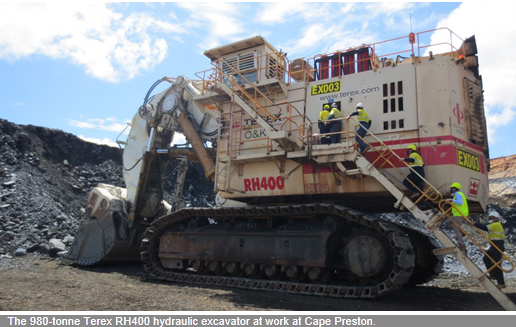 work is forging ahead to complete the six giant, seven-storey grinding mills in the crushing circuit at CITIC Pacific’s Cape Preston site in the Pilbara. At the same time the operation is producing iron for export to China.
work is forging ahead to complete the six giant, seven-storey grinding mills in the crushing circuit at CITIC Pacific’s Cape Preston site in the Pilbara. At the same time the operation is producing iron for export to China.
The hectic pace impressed Department of Mines and Petroleum Director General Richard Sellers and Mines and Petroleum Minister Bill Marmion when they visited the site in March.
The Minister and Mr Sellers toured the mammoth site with CITIC CEO Chen Zeng.
“It was an excellent opportunity for the Minister to get an update on the progress of the Sino Iron Project,” Mr Sellers said.
Mr Sellers said it was fascinating to be able to go down into the site’s mining pit and see the various processes in operation.
“We watched all the operations, from mining to crushing and dewatering and then transfer of the ore to huge barges moved by tugs to 115,000 tonne capacity bulk carriers purpose-built by CITIC to carry the ore to China,” he said.
Mr Sellers emphasised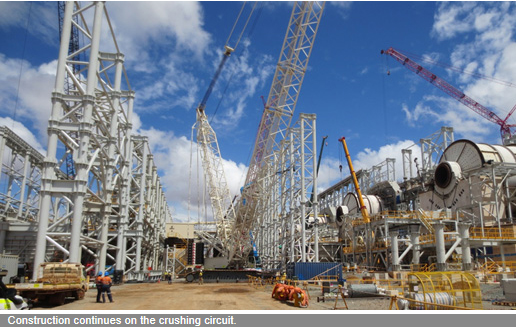 the scale and scope of Cape Preston by describing how cyclone hawsers are kept in readiness at the site’s port, even though they may never see service.
the scale and scope of Cape Preston by describing how cyclone hawsers are kept in readiness at the site’s port, even though they may never see service.
“Those massive orange ropes cost $1 million each and need to be replaced every two years,” he said.
Cape Preston is the largest magnetite mining and processing operation in Australia, with more than two billion tonnes of identified magnetite resources and an expected mine life of 25 years.
When fully developed, the mine will be about 5.5 kilometres long, two kilometres wide and 600 metres deep.
The mine is a drill-and-blast, load-and-haul, operation using some of the biggest mining equipment in the world.
During the peak construction period, 4000 people were employed in building the project and about 1000 workers will be permanently employed when the site is fully operational.
The Sino Iron Project is estimated to generate around $111 billion in direct revenue to the Australian economy, and $5.5 billion in royalties for Western Australia.
The company started producing magnetite in July 2013, with the first shipment sent to China in December of that year.
Fact file:
- CITIC
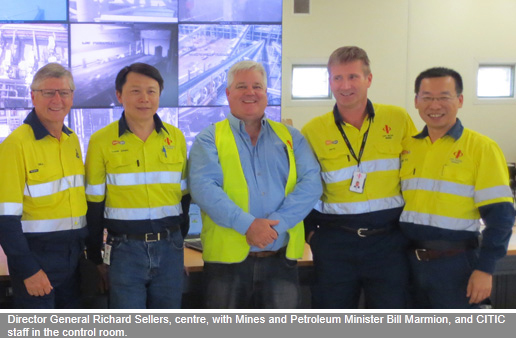 Pacific's port is the first port to be built in the Pilbara in 40 years.
Pacific's port is the first port to be built in the Pilbara in 40 years. - The breakwater extends 2.6 metres offshore from the tip of Cape Preston.
- The site’s desalination plant is about the same size as the Perth-Kwinana plant.
- The plant is producing 70 megalitres of water per day, with a final capacity of 140 megalitres per day, or 51 gigalitres per year.
- The reservoir capacity is 15 megalitres, or the equivalent of six Olympic-size swimming pools.
- The power station that will primarily power the concentrator circuit will generate electricity equal to the Pilbara’s entire capacity.
Successful second year for Mining Rehabilitation Fund
Reporting 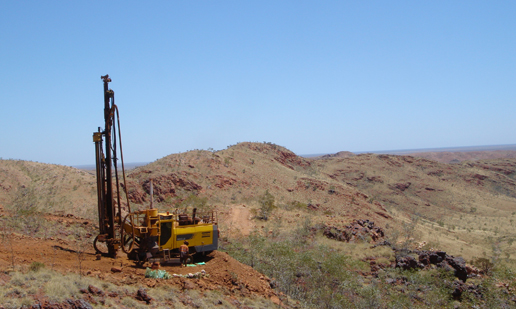 for the second compulsory year of the Mining Rehabilitation Fund (MRF) closed on 30 June 2015, with an impressive 98 per cent of reports lodged before the cut-off point.
for the second compulsory year of the Mining Rehabilitation Fund (MRF) closed on 30 June 2015, with an impressive 98 per cent of reports lodged before the cut-off point.
Department of Mines and Petroleum (DMP) Director General Richard Sellers said the 98 per cent compliance rate was nearly two percent higher than in 2014.
“Industry has really embraced the MRF which is a fantastic outcome for the department, the environment and the mining industry,” Mr Sellers said.
“The MRF is an innovative solution to the problems associated with rehabilitating abandoned mines.
“It’s an equitable system that encourages early and ongoing rehabilitation. And it’s already having positive results.
“The MRF data collected this year indicates there is seven per cent more land under rehabilitation than there was in 2014, which suggests that tenement holders understand that early rehabilitation will reduce their levy payments.”
The annual MRF levy is based on the amount and type of ground disturbance on a mining tenement, so operators reduce their levy payment by rehabilitating early.
There is currently more than $33 million in the MRF levy fund and once 2015 levy notices are paid there will be about $60 million in the fund.
The Environment Division undertook extensive engagement with industry in the lead-up to the reporting deadline.
“The MRF team went out of their way to support tenement holders and make sure their MRF reports were lodged before the deadline,” Mr Sellers said.
“Two forums were held in Perth to explain enhancements to the online reporting system, officers travelled to regional centres to provide one-on-one assistance, and tenement holders were able to visit the DMP office in East Perth or call an officer for assistance with their MRF online report.
“These sessions were obviously effective as less than 150 infringement notices for MRF non-compliance were issued this year compared to almost 1200 in 2014,” Mr Sellers said.
Manager Environmental Reform Sarah Bellamy gave a presentation on the MRF at a recent Women in Mining event organised by DMP.
“The Women in Mining event was an opportunity to share the many positive impacts the MRF has for the environment, industry and the community with industry.”
DMP is currently working on an abandoned mines project that will establish a framework to ensure MRF funds are allocated and prioritised to deliver the best outcomes for Western Australia, taking account of environmental, safety and heritage concerns.
The draft Abandoned Mines Policy is open for public feedback until 11 September and can be viewed on the DMP website.
Golden returns on incentive scheme investment
Every $1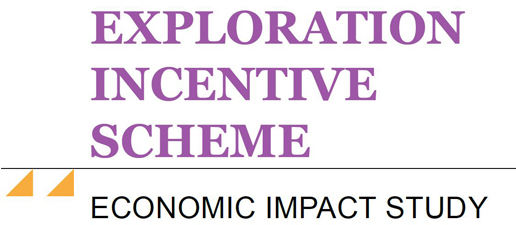 million invested in the State Government's Exploration Incentive Scheme (EIS) stimulates exploration activity generating $10.3 million in direct benefits for Western Australia, according to a recent economic impact study.
million invested in the State Government's Exploration Incentive Scheme (EIS) stimulates exploration activity generating $10.3 million in direct benefits for Western Australia, according to a recent economic impact study.
Department of Mines and Petroleum (DMP) Director General Richard Sellers applauded the results of the review by ACIL Allen Consulting which highlighted new pre-competitive geoscience as the main driver of private sector exploration investment.
Mr Sellers said the $33.3 million EIS funding for geophysical and geochemical surveys means almost the entire State is now covered by airborne magnetic and radiometric survey data, providing invaluable information for explorers.
"This has led to innovative mineral system studies in a number of areas, most recently Gascoyne Province, Edmund Basin in the Capricorn Orogen, Speewah Basin in the east Kimberley and the Yilgarn Craton," he said.
The review revealed each new data release from the Department of Mines and Petroleum's (DMP) Geological Survey of Western Australia (GSWA) has stimulated exploration activity.
The scheme was created by the State Government in 2009 to attract exploration investment leading to new discoveries.
With the encouraging of more drilling, the likelihood of major discoveries such as the Nova nickel deposit is increased, leading to a mine with jobs and royalties providing long-term benefits to the State.
The study found that every $1 million spent under the EIS generated 12.5 full-time jobs in minerals exploration for three years. It also considered the potential economic impact from the discovery and commercialisation of new mines as a result of increased exploration.
The second stage of the modelling resulted in a further $13.4 million of benefits for every $1 million invested bringing the total impact figure to $23.7 million.
Magnetic and radiometric data at a line spacing of 400 metres or less which now covers most of Western Australia is now publically available. Work has also begun on a program of 100-metre surveys over selected areas of high exploration potential.
"About one-third of the State is now covered by gravity surveys at a resolution of four kilometres or better," Dr Rogerson said.
"And last year the department completed one of the largest reconnaissance surveys in Australia — some 30,000 line-kilometres of airborne electromagnetic survey lines over an area of 145,000 square kilometres in the Capricorn region in the State's North West.
The State Government has renewed its commitment to the EIS by approving annual funding of $10 million over three financial years from July 2014 until June 2017, bringing total funding for the scheme to about $130 million.
The Co-funded Drilling Program has offered over $54 million to more than 500 projects, of which about $21 million has already been refunded to more than 260 projects.
Key discoveries resulting from the EIS include Nova nickel, Tropicana East gold, Handpump gold, Webb diamonds, Oxley potash, Camelwood nickel, Yeneena copper, McIntosh graphite, Dusk Til Dawn gold, Millennium zinc.
Additionally, EIS funding of $4.8m is extending the Perth Core Library to provide even greater resources for mineral and petroleum explorers.
The full review can be found online.
Promoting Western Australia’s resources to the world
The message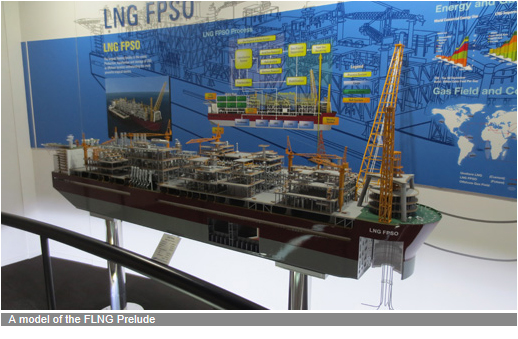 that Western Australia is the world’s destination of choice for responsible resources exploration and development has been spread around the globe in the past 12 months.
that Western Australia is the world’s destination of choice for responsible resources exploration and development has been spread around the globe in the past 12 months.
Department of Mines and Petroleum (DMP) Director General Richard Sellers, who accompanied Mines and Petroleum Minister Bill Marmion on a recent 10-day trade mission to Singapore, South Korea and China, said that the visit highlighted WA as being open for business during a period when global investment was tight.
“DMP officers visit Asia from time to time, but having the Minister spearhead a State delegation added considerable weight to our efforts to attract investment,” Mr Sellers said.
Minister Marmion spoke at the Asia Mining Congress in Singapore, opened the third annual WA-Korea Energy and Resources Forum in Seoul, and held high-level talks with government and industry leaders in China’s Shandong Province and Beijing.
“Our key message was that the time is right for Asian investors to put money into projects in Western Australia’s resources sector,” Mr Sellers said.
“Labour costs are down, we have a stable political environment, transparent and streamlined regulatory processes, and very low levels of sovereign risk.
“When you combine those factors with our close proximity to Asian markets and the fact that we are consistently in the world’s top 10 jurisdictions for investment attractiveness, Western Australia is a compelling choice for market entrants seeking sustainable, long-term returns.
“And 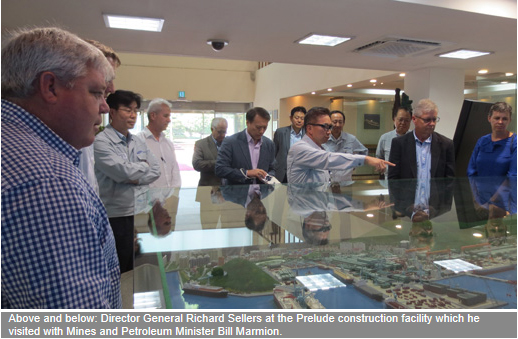 when it comes to iron ore, we made it clear that Western Australian producers are among the lowest cost producers in the world, and that this cost advantage should ensure we stay competitive in the global iron ore market.”
when it comes to iron ore, we made it clear that Western Australian producers are among the lowest cost producers in the world, and that this cost advantage should ensure we stay competitive in the global iron ore market.”
Mr Sellers said that the Minister had focused on the State Government’s efforts to help industry through challenging post-boom conditions.
In speeches and at meetings, Mr Marmion had emphasised the importance of the Government’s decision not to change royalty rates, its decision to offer one off royalty rebates of up to 50 per cent on new magnetite production, and continuing support for the Exploration Incentive Scheme (EIS).
The EIS took centre stage in March at the annual Prospectors and Developers Association of Canada (PDAC) Conference.
During his keynote address, Mr Sellers told the audience that the State Government was committed to attracting investment in Western Australia through programs and policies that provided a secure and attractive destination for resources investment.
The Director General’s presentation looked at many of the success stories that have resulted since 2009 from the State Government’s continuing commitment to the EIS that now totals more than $130 million.
“The strong message was that drilling in under-explored areas is the key to new discoveries, which create new projects – like the $440 million Sirius Resources’ Nova nickel project now under construction – and create much need employment opportunities,” Mr Sellers said.
“I also 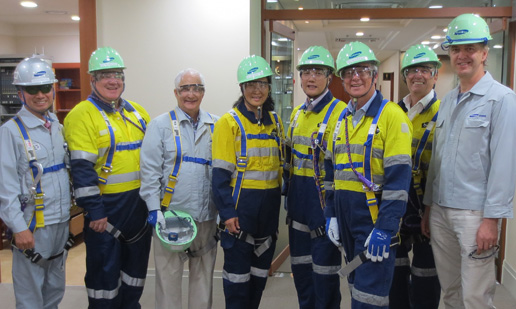 stressed the importance of EIS funding for geophysical and geochemical surveys, 3D prospectivity mapping, exploration facilitation and strategy research with industry.”
stressed the importance of EIS funding for geophysical and geochemical surveys, 3D prospectivity mapping, exploration facilitation and strategy research with industry.”
DMP Deputy Director General Tim Griffin was also busy promoting Western Australia. In March he took part in the Singapore Mining Investment Asia Conference, followed by the Mines and Money 2015 Conference in Hong Kong.
DMP Petroleum Division Executive Director Jeff Haworth flew the flag for Western Australia in Houston during January and February at the 7th annual Australian – American Chamber Energy Conference and the North American Prospecting Expo. In November last year, he took part in the 5th World Shale Oil and Gas Summit in Dallas.
The department’s Geological Survey of Western Australia (GSWA) has a targeted overseas schedule, with Executive Director Rick Rogerson and other senior Survey members to attending key events in Canada, China, India, Japan, Korea and Singapore.
Dr Rogerson led a senior delegation late last year to mark the end of the main phase of geological mapping in China’s Gansu Province in collaboration with the China Geological Survey.
“It is extremely important for GSWA to maintain and develop its international network of contacts and partnerships around the world, particularly through our regular trade missions to Asia,” Dr Rogerson said.
“Apart from renewing and establishing new relationships, we also provide information on prospectivity and policies, gather market intelligence, and make sure that any negative perceptions of Western Australia are corrected.”
2015 Aboriginal Employment Strategy success
The highly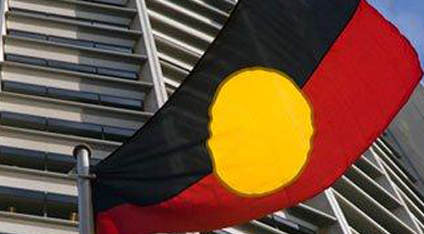 successful Aboriginal Employment Strategy (AES) developed by the Department of Mines and Petroleum (DMP) has seen an additional four Aboriginal employees join the program this year.
successful Aboriginal Employment Strategy (AES) developed by the Department of Mines and Petroleum (DMP) has seen an additional four Aboriginal employees join the program this year.
“This proactive employment strategy has seen another three Aboriginal people taking up Level 2 positions in our department, with another person being employed as a trainee Dangerous Goods Officer,” DMP Director General Richard Sellers said.
He said each new recruit had been given a 12-month contract with the department, with the possibility of permanency.
“Each employee will be provided with a high level of support including workplace buddies, a structured mentoring program and training and skill development,” Mr Sellers said.
Since the inception of the AES in 2011, DMP has employed 22 Aboriginal staff through the employment strategy.
The new employees will be working across the department in the Human Resources, Resources Safety, Environment branches.
Each year the department holds an Aboriginal Employment Strategy Open Day which was again well attended by interested applicants.
“At the open days applicants get the opportunity to hear about the careers on offer at DMP, as well as an understanding of what it is like to work at DMP,” Mr Sellers said.
Attendees 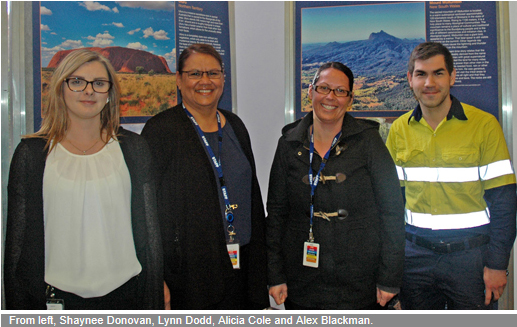 also had the opportunity to participate in recruitment and selection workshops and receive resume and interview coaching.
also had the opportunity to participate in recruitment and selection workshops and receive resume and interview coaching.
It was a highly competitive field this year and the successful applicants for the Level 2 Administrative Assistant positions were Shaynee Donovan (Human Resources), Alicia Cole (Resource Safety) and Lynn Dodd (Environment ), while Alex Blackman was successful in obtaining a Level 3 position (Resources Safety).
“This is an exciting new position and Alex is expected to eventually work with remote Aboriginal communities. I wish all of this year’s intake well,” Mr Sellers said.
The positions will initially be for 12 months, with a commitment, based on the occupant’s performance, for potential permanent employment within the department.
NAIDOC Week
In early July, as part of the Reconciliation Action Plan (RAP), the department also celebrated NAIDOC Week.
The celebrations commenced with the opening for NAIDOC Week activities when almost 50 staff attended two events facilitated by Creative Native – ‘How to play a didgeridoo’ and ‘Get Creative with dot painting’.
Jilan Shah gave partici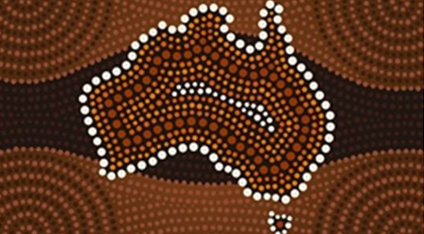 pants a demonstration on how to play the didgeridoo and told a story about the history of this traditional and unique instrument, while Beverley Egan taught participants the techniques of dot painting.
pants a demonstration on how to play the didgeridoo and told a story about the history of this traditional and unique instrument, while Beverley Egan taught participants the techniques of dot painting.
Participants managed to finish five creative masterpieces to display around DMP buildings.
During the week the ground floor of Mineral House was the venue of a popular photo exhibition of 10 sacred sites around Australia.
The sacred sites tied in with NAIDOC Week’s 2015 theme, ‘We all stand on sacred ground – Learn, respect and celebrate’, and each picture included a brief paragraph about the Dreamtime stories behind the sacred sites.
Another popular event that saw more than 50 staff attending was the DMP Annual Boomerang Throwing and BBQ with a demonstration from Neville Collard.
Finally DMP staff held a stall at the Ashfield Family Day last Thursday at Ashfield Reserve.
The Ashfield Family day is a free vibrant community festival which showcases the rich and diverse Aboriginal and Torres Strait Islander cultures in a fun family-friendly atmosphere.
DMP used the event to promote the Aboriginal Employment Strategy, the temporary employment register and the work of DMP in the WA community.
Highlighting hygiene management
During 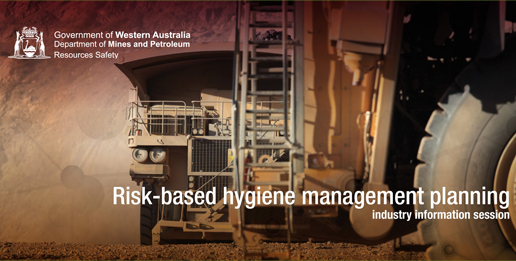 May information sessions for hygiene management planning were held by the Department of Mines and Petroleum’s Resources Safety Division in Kalgoorlie and Perth.
May information sessions for hygiene management planning were held by the Department of Mines and Petroleum’s Resources Safety Division in Kalgoorlie and Perth.
Resources Safety Acting Executive Director Ross Stidolph said the sessions were about providing education and information about risk-based hygiene management planning (RBHMP) and containment monitoring (CONTAM) procedures.
“The sessions focused on ventilation, managing noise and diesel emission management plans, as well as hygiene management and CONTAM procedures.
“The aim was to raise awareness about applying a risk-based approach to occupational health and hygiene on Western Australian mining operations.”
The sessions targeted occupational safety and health personnel, ventilation officers and external hygiene service providers.
Environmental regulatory reform update
The Mining 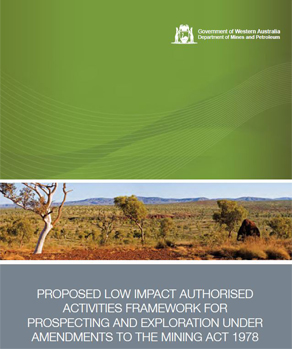 Legislation Amendment Bill 2015 was introduced to the Western Australian Parliament on 22 April 2015.
Legislation Amendment Bill 2015 was introduced to the Western Australian Parliament on 22 April 2015.
The Bill will amend the Mining Act 1978 to allow for the final stage of environmental reform that the Department of Mines and Petroleum (DMP) committed to in 2012 as part of the Reforming Environmental Regulation program.
DMP Executive Director Environment Dr Phil Gorey said the Amendment Bill modernises environmental regulation and will simplify the environmental approvals and compliance processes.
“The Amendment Bill will remove the requirement for native vegetation clearing permits under the Mining Act, consolidate multiple site approvals and create a new notification system for low impact activities,” he said.
The introduction of the low impact notification process has been the most high profile of these proposed amendments.
“Once introduced, the low impact notification system will mean that exploration and prospecting activities deemed to have a low environmental impact will be approved using an automatic assessment process,” Dr Gorey said.
“Low impact exploration and prospecting activity will be subject to prescribed environmental standards and conditions that will need to be reported against annually.
“This new approach will enable DMP to reduce timelines for approval of mining activities deemed to have low environmental impact.”
Mine guide good for environment and industry
A 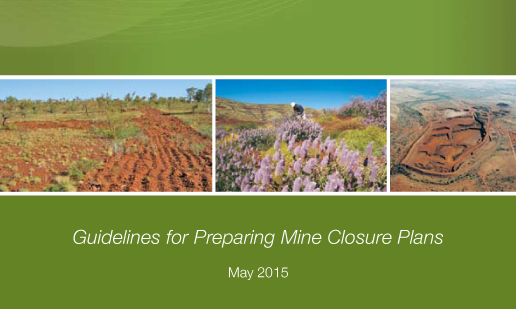 comprehensive new guide to help Western Australian mining operators clearly understand their mine closure, decommissioning and rehabilitation obligations was released in May.
comprehensive new guide to help Western Australian mining operators clearly understand their mine closure, decommissioning and rehabilitation obligations was released in May.
DMP Director General Richard Sellers said the revised 'Guidelines for Preparing Mine Closure Plans 2015' would benefit the resources industry and the environment.
The guidelines were jointly developed by DMP and the Environmental Protection Authority (EPA), following publication of the original mine closure guide in 2011.
Mr Sellers said planning for mine closure started well before mining projects commenced and continued throughout the life of the mine.
He said two public comment periods and a workshop convened by the Chamber of Minerals and Energy of Western Australia had yielded valuable comments and suggestions from mining and environment groups.
"The new guidelines will help ensure Western Australian mines are decommissioned in an ecologically sustainable manner and are left in a stable, non-polluting condition," Mr Sellers said.
"They will also simplify processing of mine closure assessments and approvals, through consistent requirements from the EPA and the DMP."
The 'Guidelines for Preparing Mine Closure Plans 2015' is available on the DMP website.
DMP adapts for smart phones and tablets
Leaders 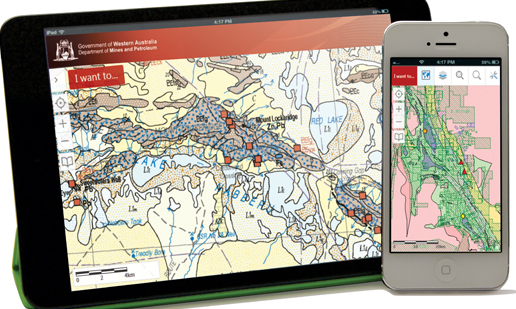 cannot afford to be complacent in a fast-changing business world.
cannot afford to be complacent in a fast-changing business world.
This was Department of Mines and Petroleum (DMP) Director General Richard Sellers’ message to the National Public Sector Managers and Leaders Conference in Melbourne in April this year.
“The development of smart phones is a prime example of the power of change,” Mr Sellers told delegates to Australia’s peak public sector leadership event.
“They have become ubiquitous across the developed world, yet the first iPhone was only released in 2007,” he said.
“There is more power in one of these small devices than all the computing power NASA required for the Apollo 11 mission.”
Mr Sellers said that smart phones and tablets had changed the way DMP did business.
“We are redesigning our website and enhancing how the site displays on tablets and smartphones,” he said.
“Our Geological Survey of Western Australia has also recently released tablet and handheld-friendly versions of its popular online interactive geology mapping tool, GeoVIEW.WA, and the new WAGeology app.”
GeoVIEW.WA, which allows users to view, query, and map geoscientific datasets, won the Spatial Enablement category at the 2013 WA Spatial Excellence Awards. WAGeology displays geoscience maps, mining and petroleum tenements, mineral deposits and petroleum information.
Mr Sellers said that another challenge that must be accepted and met by leaders is the way organisations interact with the stakeholders and the community.
“Engagement is a critical part of our business – whether it’s industry, other government agencies, NGOs or community groups, organisations are expected to be increasingly transparent,” he said.
The Director General said that community engagement was being embedded in all DMP processes.
He also pointed to the need for organisations to have a comprehensive and continuing program of improvement for staff to make sure their skills and training kept pace with change.
“Change is inevitable,” he said. “We must ensure that our organisations have a workplace culture that not only embraces change, but fosters a desire for change.
“You cannot afford to be complacent. The way we do things today, will not be the way we do things in the future.”
DMP online tenement system updated
An update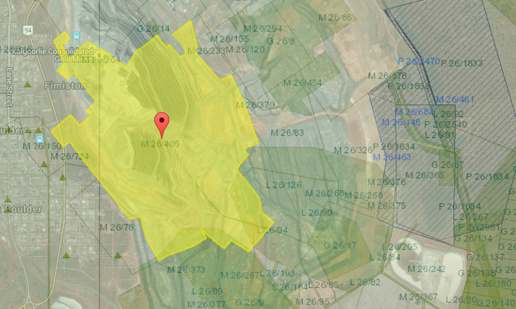 to the Department of Mines and Petroleum’s (DMP) online tenement system is addressing concerns about access to surrendered tenements.
to the Department of Mines and Petroleum’s (DMP) online tenement system is addressing concerns about access to surrendered tenements.
Earlier this year, concerns were raised about some companies using special software to ‘crunch’ DMP online systems.
The department’s Mineral Titles Division Executive Director Dr Ivor Roberts said the issue could disrupt the department’s online systems.
“To ensure equity, the department has upgraded its online system to ensure that once a tenement has been surrendered the details are freely available online,” Dr Roberts said.
This free information is visible to everyone at the same time through the department’s website and is also distributed by an RSS feed.
Additionally, detailed and cost-free tenement information from the department’s systems will be available for download the following day.
The changes ensure information about tenement availability is provided free of charge as soon as a tenement has been surrendered.
The upgrades will also help companies audit and manage their tenements for compliance, as well as determine when ground was available.
The department plans to introduce a training program on using the upgraded system as a part of the regular online training courses available to the public.
Innovative web tool simplifies MRF compliance
The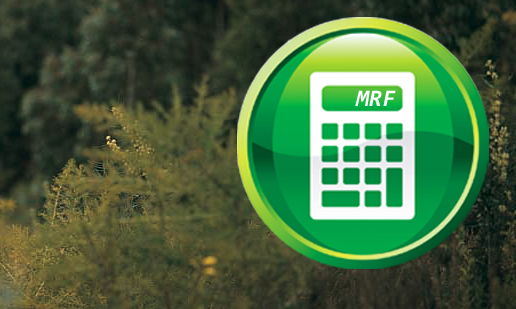 Department of Mines and Petroleum (DMP) has developed an online calculator that allows mining tenement holders to quickly estimate rehabilitation costs and whether they qualify for exemptions from Mining Rehabilitation Fund (MRF) levies.
Department of Mines and Petroleum (DMP) has developed an online calculator that allows mining tenement holders to quickly estimate rehabilitation costs and whether they qualify for exemptions from Mining Rehabilitation Fund (MRF) levies.
DMP Director General Richard Sellers said the innovation was in response to industry requests as part of the MRF reforms to assist in streamlining regulation in the resources industry, and was launched in May.
He said the tool would not only allow tenement holders to calculate the MRF levies payable at different levels of disturbance, but also shows how much can be saved by early rehabilitation.
Tenements with rehabilitation liabilities less than $50,000 are not required to contribute to the MRF.
"This means many small prospectors and explorers will not have to pay levies at all, provided they rehabilitate disturbance as they go," Mr Sellers said.
MRF levies are calculated at one per cent of the Rehabilitation Liability Estimate (RLE) on a tenement at an annual reporting date.
The new calculator allows tenement holders to enter individual activity types, for example roads or tailings storage facilities, or combine multiple activities into a single Mine Activity Type, and estimates the RLE using the information provided.
Tenement holders who use the new calculator must still submit their annual MRF disturbance report.
The MRF now contains more than $33 million, with interest earned set to be used to rehabilitate abandoned mine sites.
MRF reports for the 2014-15 reporting period were required to be submitted by June 30, 2015.
The online calculator can be accessed on the DMP website.
MRF Roadshow hits Goldfields and Mid-West
During 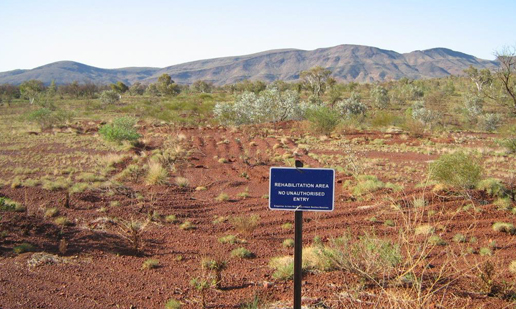 May staff from the Department of Mines and Petroleum (DMP) visited the Goldfields and Mid-West to assist tenement holders with one-on-one assistance to lodge their compulsory 2014-15 Mining Rehabilitation Fund (MRF) reports.
May staff from the Department of Mines and Petroleum (DMP) visited the Goldfields and Mid-West to assist tenement holders with one-on-one assistance to lodge their compulsory 2014-15 Mining Rehabilitation Fund (MRF) reports.
The MRF team visited Kalgoorlie, Coolgardie, Leonora, Sandstone and Leinster in the Goldfields and Sandstone and Mount Magnet in the Mid-West.
Tenement holders in those regions had the opportunity to seek clarification on any problems they may be having with their MRF reports, and receive assistance with their online lodgement.
The compulsory online report for 2014-15 was required to be submitted by 30 June to avoid penalty.
Members of the MRF team were also available to assist tenement holders at the department’s head office in East Perth.
Disturbance data must be lodged annually, even if tenement holders fall below the threshold and have no levy to pay.
DMP wins WorkSafe Gold Certificate of Achievement
Last month 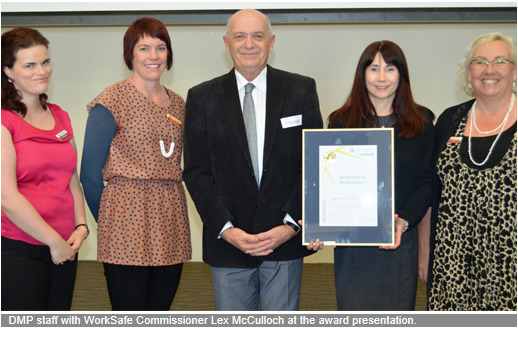 the Department of Mines and Petroleum (DMP) was officially presented with the Worksafe Gold Certificate of Achievement for its Safety Management System.
the Department of Mines and Petroleum (DMP) was officially presented with the Worksafe Gold Certificate of Achievement for its Safety Management System.
This achievement builds on the Silver Certificate of Achievement presented to DMP in 2011.
DMP Director General Richard Sellers applauded the win, saying it was a credit to the dedication and determination of staff involved in occupational safety and health.
“This is a great result and I heartily congratulate everyone involved,” he said.
“It is important to make sure we keep our eyes on the ball in the area of occupational safety and health because the wellbeing of our staff is paramount.”
An external audit last year of the Safety Management System, covering all of DMP’s metropolitan and regional locations, found the department qualified for the Gold Certificate.
The audit recorded that DMP had achieved a score of more than 80 per cent combined with a low lost time incidence (LTI) rate and had made significant improvements on its 2011 performance.
The audit outlined some of the safety management system’s key strengths, including:
- Strong management commitment
- Continuous improvement of the system
- Good integration of the Facilities Services Branch and Corporate Occupational Safety and Health (COSH)
- Strong visible presence of COSH awareness throughout the department
- When interviewed, staff demonstrated strong knowledge of OSH, COSH and the department’s Working on Wellness Program.
- Staff were found to have an “overwhelming perception” that safety is well managed by the department and that their concerns are considered.
The Gold Certificate, which lasts for two years, was presented by the WorkSafe’s Commissioner Lex McCulloch.
DMP calls for volunteers to test new website?
The 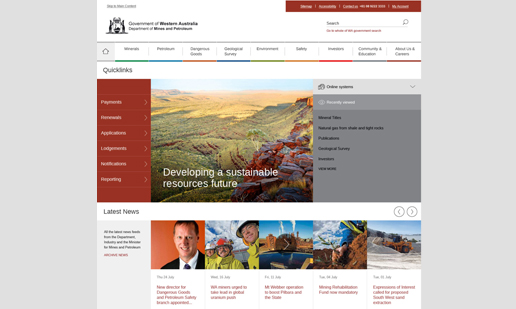 Department of Mines and Petroleum (DMP) will conduct user testing of its new website during the week of 14-18 September and is calling for volunteers to help test the new site.
Department of Mines and Petroleum (DMP) will conduct user testing of its new website during the week of 14-18 September and is calling for volunteers to help test the new site.
The department is looking for volunteers who regularly use the DMP website and who meet one of the following user profiles:
- environmental consultant
- geologist
- mine manager
- safety and health representative
- dangerous goods driver
- community representative (e.g. teacher, local council member)
A mix of users from each group will test the useability of the website when accessing it by a personal computer, mobile phone or tablet.
The testing will help ensure the department’s new website meets useability goals, and will allow DMP to address any useability concerns that are revealed prior to the launch.
The user testing will take approximately one hour and will be conducted by an independent, expert web consultant at the DMP offices in East Perth.
If you fit one of the above user profiles and are interested in taking part in user testing please submit your details via the following short survey.
A DMP officer will then contact you to discuss your involvement.